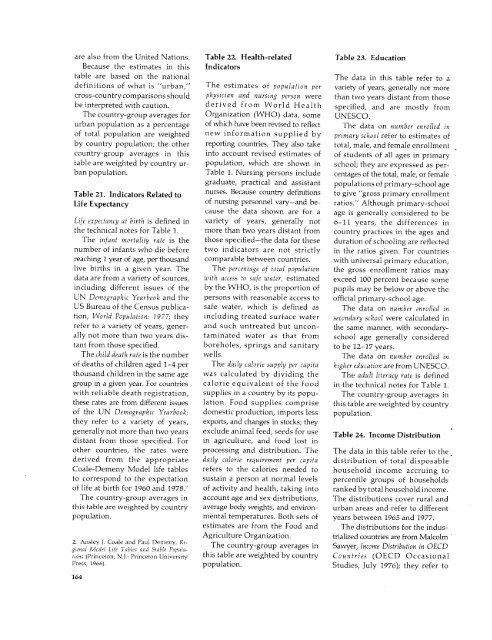World Bank Document
World Bank Document
World Bank Document
- No tags were found...
You also want an ePaper? Increase the reach of your titles
YUMPU automatically turns print PDFs into web optimized ePapers that Google loves.
are also from the United Nations. Table 22. Health-related Table 23. EducationBecause the estimates in this Indicatorstable are based on the national The data in this table refer to adefinitions of what is "urban," The estimates of population per variety of years, generally not morecross-country comparisons should physician and nursing person were than two years distant from thosebe interpreted with caution. derived from <strong>World</strong> Health specified, and are mostly fromThe country-group averages for Organization (WHO) data, some UNESCO.urban population as a percentage of which have been revised to reflect The data on number enrolled inof total population are weighted new information supplied by primary school refer to estimates ofby country population; the other reporting countries. They also take total, male, and female enrollmentcountry-group averages in this into account revised estimates of of students of all ages in primarytable are weighted by country ur- population, which are shown in school; they are expressed as perbanpopulation. Table 1. Nursing persons include centages of the total, male, or femalegraduate, practical and assistant populations of primary-school ageTable 21. Indicators Related to nurses. Because country definitions to give "gross primary enrollmentLife Expectancy of nursing personnel vary-and be- ratios." Although primary-schoolcause the data shown are for a age is generally considered to beLife expectancy at birth is defined in variety of years, generally not 6-11 years, the differences inthe technical notes for Table 1. more than two years distant from country practices in the ages andThe infant mortality rate is the those specified-the data for these duration of schooling are reflectednumber of infants who die before two indicators are not strictly in the ratios given. For countriesreaching 1 year of age, per thousand comparable between countries, with universal primary education,live births in a given year. The The percentage of total population the gross enrollment ratios maydata are from a variety of sources, with access to safe water, estimated exceed 100 percent because someincluding different issues of the by the WHO, is the proportion of pupils may be below or above theUN Demographic Yearbook and the persons with reasonable access to official primary-school age.US Bureau of the Census publica- safe water, which is defined as The data on number enrolled intion, <strong>World</strong> Population: 1977; they including treated surface water secondary school were calculated inrefer to a variety of years, gener- and such untreated but uncon- the same manner, with secondaryallynot more than two years dis- taminated water as that from school age generally consideredtant from those specified. boreholes, springs and sanitary to be 12-17 years.The child death rate is the number wells. The data on number enrolled inof deaths of children aged 1-4 per The daily calorie supply per capita higher education are from UNESCO.thousand children in the same age was calculated by dividing the The adult literacy rate is definedgroup in a given year. For countries calorie equivalent of the food in the technical notes for Table 1.with reliable death registration, supplies in a country by its popu- The country-group averages inthese rates are from different issues lation. Food supplies comprise this table are weighted by countryof the UN Demographic Yearbook; domestic production, imports less population.they refer to a variety of years, exports, and changes in stocks; theygenerally not more than two years exclude animal feed, seeds for use Table 24. Income Distributiondistant from those specified. For in agriculture, and food lost inother countries, the rates were processing and distribution. The The data in this table refer to thederived from the appropriate daily calorie requirement per capita distribution of total disposableCoale-Demeny Model life tables refers to the calories needed to household income accruing toto correspond to the expectation sustain a person at normal levels percentile groups of householdsof life at birth for 1960 and 1978.2 of activity and health, taking into ranked by total household income.The country-group averages in account age and sex distributions, The distributions cover rural andthis table are weighted by country average body weights, and environ- urban areas and refer to differentpopulation. mental temperatures. Both sets of years between 1965 and 1977.estimates are from the Food and The distributions for the indus-Agriculture Organization. trialized countries are from Malcolm2. Ansley J. Coale and Paul Demeny, Re- The country-group averages in Sawyer, Income Distribution in OECDgional Model Life Tables and Stable Populations(Princeton, N.J.: Princeton University this table are weighted by country Countries (OECD OccasionalPress, 1966). population. Studies, July 1976); they refer to164
















